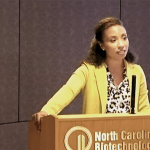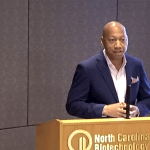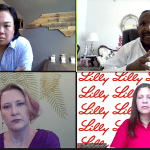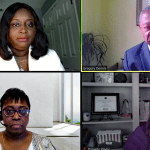NCBIO Roadmap to Diversity offers strategies for building diverse and inclusive organizations
View Agenda (0.4MB PDF)
View keynote slide deck (2.6MB PDF)
NCBIO hosted its first event in the Roadmap to Diversity in Life Sciences series on Tuesday, Aug. 24, featuring experts in diversity, equity and inclusion from a number of North Carolina life sciences companies who shared their experience in recruiting and retaining a diverse workforce.
Event co-chairs Shaylah Nunn Jones, J.D., principal, government and public affairs at Novo Nordisk, and Neil Jones, vice president, corporate strategic partnerships at Lindy Biosciences, opened the event. Mona Babury, M.B.A., global diversity, equity and inclusion leader at Pfizer, was the keynote speaker.
Babury kicked things off talking about the difference between equality, which she defined as giving everyone the same thing, and equity, which is understanding what each person actually needs to succeed.
“Equity is hard,” she said. “It takes more time, it takes more investment, it takes more work. But it’s the right thing to do.”
Babury talked about how diversity, equity and inclusion are addressed at Pfizer. She said that Pfizer is making sure the DEI is part of all aspects of its business. Examples include a commitment to pay equity, matching clinical trial demographics to country demos that address health inequities and increasing spend with suppliers with a greater diversity of ownership.
To implement a DEI initiative, Babury laid out a five-step process.
- Start with data. “You can’t understand your opportunities until you understand the data,” she said. Leaders need to understand the facts to make the right decisions.
- Establish aspirational goals. For example, Pfizer wanted its leadership to reflect the makeup of its workforce.
- Put together a plan. How will you sourcing, retain and grow talen? How will you engage your workforce?
- Ensure support from leadership. DEI initiatives must start with the CEO and cascade from the top down, she said.
- Establish accountability and measure progress. Progress toward DEI goals could be tied to compensation, she said, or companies can use a lighter touch.
To successfully incorporate diversity, equity and inclusion in your organization, you have to think differently about your workforce and about how committed you are to lead courageously, Babury said.
“A lot of my conversations start with ‘I have an idea, you may not like it,’”, she said. “Find your circle at your company that can help drive your ideas and build trust. You have to intentionally seek out those people.”
Attract and Recruit
A panel discussion focusing on attracting and recruit a diverse pool of talent followed the keynote. Moderated by Tiffany Oettinger, associate director, external manufacturing at Merck, the panel comprised
- Sheryl Gonzalez, associate consultant, recruiting at Lilly;
- Dawn Losinger, director, talent acquisition and management at Precision Biosciences; and
- Richard Stallings, diversity, equity and inclusion manager at Novozymes.
Oettinger started off by asking the panelists to address some common pitfalls in recruiting that companies may not be aware of.
Gonzalez encouraged companies to plan ahead and build a pipeline that would feed their need for talent.
“Look at nontraditional sources,” she said. “People from diverse backgrounds may not have taken a traditional past to success. They may have been working while studying and completed their degrees much later than traditional students.”
Stallings advised companies to listen to their employees to inform the hiring process.
“Their voices are critical,” he said.
Losinger advised those involved in hiring to examine their unconscious biases, which can be challenging as unconscious bias is something you don’t know you have.
What language in job postings could turn off diverse candidates? Oettinger asked next.
Losinger said that companies should work to eliminate gender from their postings. Use “they” or “the employee” in job descriptions rather than he or she. Eliminate gender coded words: “guru” and “rock star” may target men while “collaborative” and “supportive” can be biased toward women, she said. She suggested running a posting through a gender decoder to help spot language that may have a bias.
She advised scrutinizing a job description to make sure that requirements are really requirements and not just preferences.
“Is a degree really necessary, or is there equivalent combination of experience and training?” she said. “Don’t exclude disability. Does a person really need to lift 50 pounds or just move it? Do they really need to stand for an extended period or do they just need to be stationary? Don’t use terms like digital native, which refers to a younger candidate, when you really need technical skills.”
Panelists cautioned that a poorly written job description combined could cause an applicant tracking system used to automate applicant screening to reject candidates that the company is actually trying to attract.
Gonzalez said that Lilly is not using an ATS to review resumes because it eliminates people too quickly, especially if the job description is not well done.
Oettinger asked the panel how can companies can encourage hiring manager to challenge their biases?
“We must recognize and accept that we all have biases. All of us,” Stallings said. Managers need ongoing learning and development training, not one and done training events.
“It starts with us, the person in the mirror,” he said. “We want all our managers to be comfortable having very uncomfortable conversations around hiring practices.”
Gonzalez pointed out that becoming aware of biases at a very personal level takes time.
“We all have biases and we’re all on a journey of knowledge,” she said.
Engage and Retain
The second panel focused on engaging and retaining a diverse and inclusive workforce. Melissa Bishop-Murphy, J.D., M.B.A., senior director, national government relations and multicultural affairs at Pfizer served as moderator. The panel comprised
- Gregory Dennis, M.D., senior vice president, research and development, and global head, therapeutic science and strategy at IQVIA;
- Danielle Pavliv, director, chief diversity officer at SAS; and
- Yvette Pittman, global diversity, equity and inclusion manager at Biogen.
Pavliv said that while the Triangle is a growth and innovation hub for a number of industries, the Great Resignation that we’re experiencing right now as a nation means we’re dealing with borderless hiring and a demand for flexible work hours and locations. Employees, particularly millennials, are looking for meaningful work, growth opportunities and flexibility, she said.
“They want to live and work wherever they want and not be glued to a desk,” she said. “They want to feel invested in and have a sense of belonging and representation.”
All the panelists agreed that employee resource or interest groups where employees with shared backgrounds, experiences or interests are important to their company.
Pittman said that Biogen relies on input and guidance from their internal employee resource network led by committed volunteers. The company hosts “office hours” calls where employees can share how national and world events affect them. Hundreds of employees participate in these calls, she said.
Dennis said that IQVIA’s employee groups get involved in company operations, such as pushing for more diversity in clinical trials. “Get them [employees] more involved in what you do as a company, and they will feel very gratified,” he said.
How do we make biotech careers attractive to diverse candidates, Bishop-Murphy wondered.
“We have to make it fun. It has to be interesting,” Dennis said. “They have to be able to see themselves in the career, see their path of advancement and see that they will have the necessary work-life balance.”
What are the challenges and barriers to building environment of diversity, equity and inclusion, Bishop-Murphy asked?
“It can be hard to see the value up front in doing something different,” Pavliv said. “People need to see they’re not losing anything by fostering a diverse and inclusive environment. They are gaining.”
Change management is the hardest part, Pavliv said.
“Selling people on DE&I is not hard, but getting people to change their behavior is really hard.”
Pittman said, ”This work is not easy. You have to come to a place where you accept that everyone doesn’t see things through your lens.”
She recommended that you focus on at least getting them to acceptance of and compliance with DEI initiatives. Align DEI activities with stakeholder interests and be sure that there is consistent messaging from the top. “Be in it for the long haul.”
Dennis said, “To advance these initiatives, we have to realize that they’re not part of employees’ day jobs. We have to provide support and resources for these programs to succeed. They can’t be something that gets piled on to current duties."







